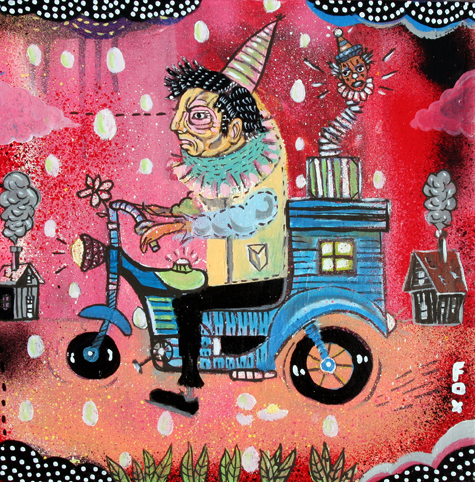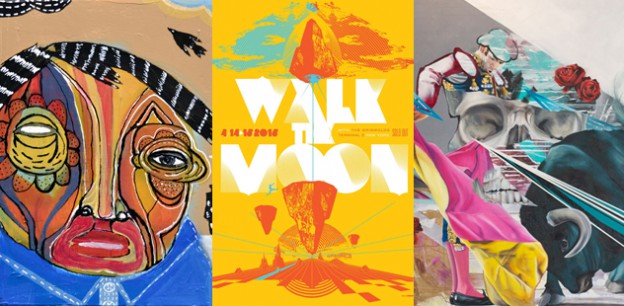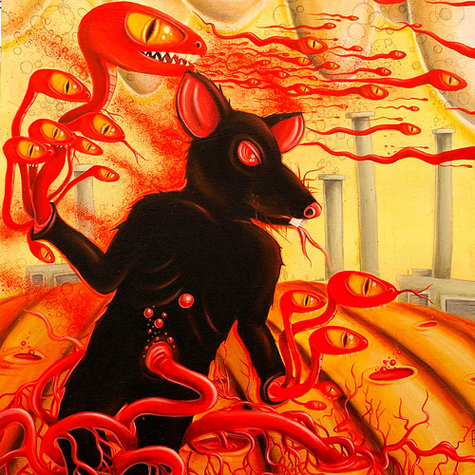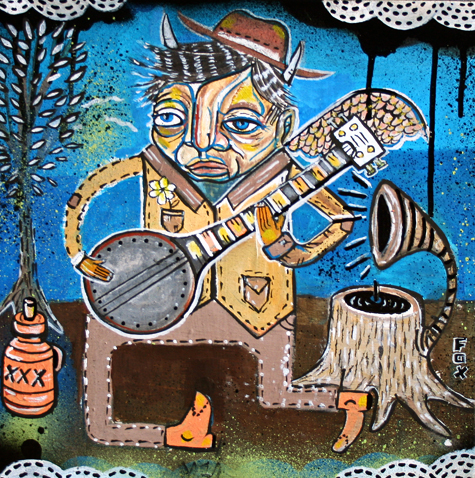Self-taught local mixed media painter Mark Fox makes “urban outsider folk art” that we’ve been big fans of since first discovering his stuff back in ‘08. In fact, after featuring him in the mag way back then, we even collaborated with him on a Submerge T-shirt design (hit us up if you want one, we might have a couple lying around). His style is unique and he’s been doing his thing for many years, having really mastered his craft. Check out Mark Fox and Friends in person at Little Relics (908 21st Street, Sacramento) through Oct. 31, 2015. Gallery hours are Monday through Friday 11 a.m.–6 p.m.; Saturday and Sunday 11 a.m.–4 p.m. Visit Mark-fox.com for more on the artist.
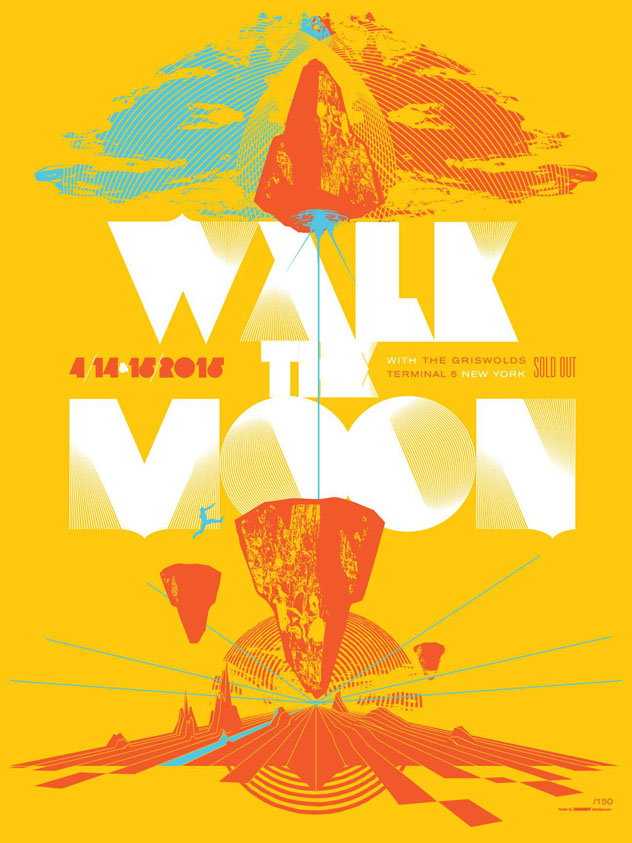
“A decade of musical ephemera, propaganda and juvenalia” is what to expect when you step foot into the University Union 2nd Floor Gallery at Sacramento State to see Better Living Through Modern Lehzure: The Gigposters of Jason Malmberg. Malmberg’s resume is impressive: he’s currently the head designer behind TBD Fest’s slick branding, he’s also Sactown Magazine’s art director, and he’s even created official gig posters for such acts as Cut Copy, Justice, Foals, Drive-By Truckers, Future Islands, Mogwai, The Walkmen, Surfer Blood … the list goes on and on. His solo show at Sacramento State runs Oct. 26 through Nov. 19, 2015. Opening reception is Oct. 29 from 6–8 p.m. Free and open to the public. Check out Decabet.com for more on the artist.
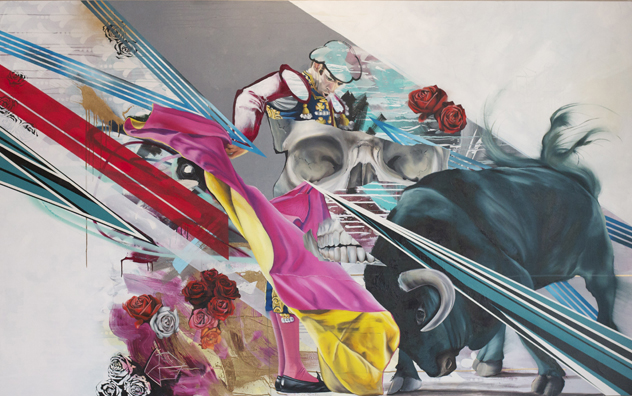
A native of Santa Cruz, Jeremiah Kille is the epitome of the word “maker.” When he’s not hand-shaping surfboards, he’s creating insanely amazing artwork that explores “themes of nature and coexistence.” Some of his work is currently up at The Urban Hive (1931 H Street, Sacramento) and we highly suggest stopping in to see it with your own two eyes. Some of the paintings are huge and jaw dropping. The show is up through Oct. 31, 2015. Visit Jeremiahkille.com to learn more about the artist.
–JC
In order to properly celebrate local artist John Stuart Berger’s 20-plus years of showing art in the Sacramento community, the Fe Gallery is hosting a music and art gathering with a few of Berger’s close friends. Berger is known for creating colorful abstract art depicting animals and insects that most people could only imagine in their dreams. The celebration begins Saturday, March 10, 2012 from 6 to 9 p.m. showcasing art from Skinner, Robert Bowen, Matt136, Kim Scott, Carrie Cottini, Allen Carrier, Mark Fox, Val Fernandez, Melanie Bown, Ianna Frisby and many more. Also, stay tuned for live performances by Sacramento musicians like Jackson Griffith, Bobby Jordan, Kevin and Allyson Seconds, Andy Sheppard and Kepi Ghoulie. For more information call (916) 456-4455 or visit Fegallery.com
The Scary Art Collective Brings Their Art to the People
A fault of artists is their inability to comprehend a recession. Despite being conditioned for poverty, artists on the Second Saturday circuit continue to tag their work with lofty prices, turning a cold and dented shoulder to the slimmed pockets that stroll through the galleries.
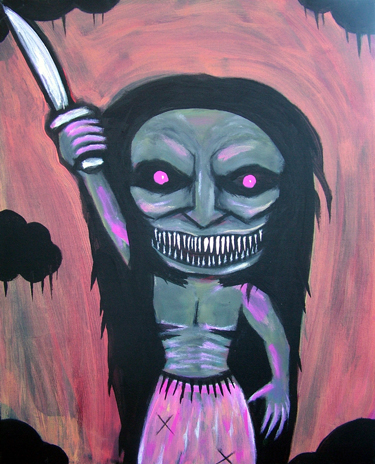
Nicolas Caesar does not have the privilege of letting his art remain in his possession. He’s got bills to pay. Call it low brow, call it tawdry, call it plebeian, but you can’t call it depreciated, as Caesar and his Scary Art Collective are selling their art before they can get it out of the boxes.
Chip Conrad, owner of Bodytribe Fitness, was the first to coin the collective. Four years ago, Conrad opened his fitness center to Caesar and his friends to use as an art gallery one Halloween, the only holiday that complements Caesar’s macabre style. “I remember getting this Myspace message asking if I wanted to show my art in a gym,” he said. “I totally thought I was walking into [a situation] of getting raped, but I’m like the girl who can’t say no.” Caesar did not get harmed, physically or emotionally; instead he formed a friendship that led to a love for the Sacramento art scene. It was a love that he described as a refreshing escape from the Bay Area scene.
From there, it became a repetition of faces. At galleries in Midtown or San Francisco, Caesar was showing his work and cheering beers next to the same few people. In this overlapping, Mark Fox, Temple Terkildsen, Cinder, Krissi Sandvik and Caesar began seeking each other out and sharing galleries. The loose organization has an unrecorded number of members, with an East Coast and West Coast branch. “Since we share the same territory, it’s a cross between Thanksgiving and AA,” he said. “We all share our tragic stories and our successes. Every Second Saturday is like meeting up with our second family.”
The art is mostly Gothic and dark, pulling inspiration from horror movies and the morbid subconscious. The artists share a magnetic desire to express their darkest thoughts, creating an organization comprised of your garden-variety goths to the criminally insane. Caesar is a pen pal with convicted serial killer Wayne “Skid” Lo, who is not a member. “Wayne is not officially a member of the Scary Art Collective,” Terkildsen said. “But, he does trade art with Nick.”
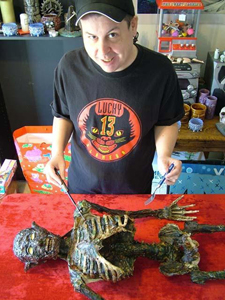
“My whole feeling about it is, the guy’s in prison,” Caesar said regarding his lack of concern. Caesar bought a piece of Lo’s art called Flushy the Toilet Monster. All of the proceeds from Lo’s art go to the victims’ families. “I’m gaining the Gilligan’s Island of strange and weird people [in my life],” Caesar said. “Weirdness is attracted to us.”
Living among the proletariat, Caesar is a self-proclaimed artistic anarchist who disregards the traditional rules of gallery art. He markets his work to the collectors and appreciators that keep a 30 pack of Pabst Blue Ribbon in their refrigerators and eat Top Ramen to get by. “I sell to my own demographic,” he said. “[Artists] don’t really understand who collects their art”¦ Artists have to go back to catering to the people.”
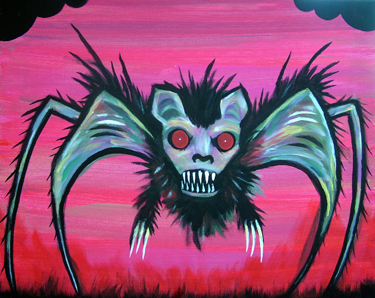
Terkildsen said the members of the collective are firm believers in the bartering system. On a slow night, she’ll trade two cases of beer for her art. “I’ve traded a painting for a haircut,” Terkildsen said. Essentially, they sacrifice the pompous satisfaction of selling one great piece at top value for the opportunity to put hundreds of pieces in as many living rooms as possible. Caesar and Terkildsen do not hesitate to call themselves art gypsies.
For Caesar and Terkildsen, the collective is an extension of their daily routines. Terkildsen said she works her shitty part-time job, works on art for four hours at home and then spends the remainder of the night at Caesar’s home drinking the Blue Ribbon and watching campy horror films. With work habits like that, the duo produce more art than they can store in their homes, making the bartering system all the more necessary.
“I’ve actually timed this,” Caesar said. “I can make three pieces to the movie Escape from New York.”
They are unapologetic in their merits. Both artists recognize the critiques that can be made of their leftist perspective, but they seem to revel in the judgment. Caesar said the collective’s strongest attribute is a lack of competitiveness in a cutthroat profession. Before founding Scary Art, he was frustrated with the unwillingness of his contemporaries to share galleries and the snootiness that comes with a saturation of artists. The Scary Art Collective aims to redefine the relationship between artists and galleries by operating outside traditional spaces. The collective has had shows in adult boutiques, tattoo studios, S&M clubs, gyms, coffee shops, bars, horror and comic conventions, warehouses and churches. Caesar likes Sacramento because of its bounty of unique spaces run by down-to-earth people.
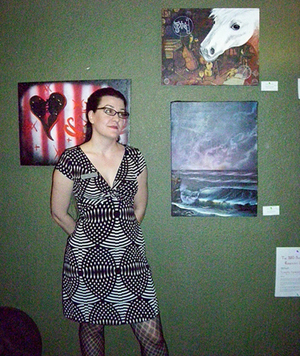
Terkildsen described the horror of galleries outside of Midtown, expressing a loathing for curators who proclaimed they could not show her art due to its pricing. “You’re in a fine art gallery with a bunch of fuckheads you’d never talk to and you think, ‘Wow I really can’t stand this,'” she said. “Immediately, I want out and to be doing a show with Nick. I prefer the open flea market of Midtown.”
Ritually our conversation came back to PBR and living a life without the knowledge of which fork is for salads. To the affluent, this might seem like a life devoid of taste, but Caesar and Terklidsen’s art reflects a deep-seated passion for beer and cheap horror films. Read any of his comics and you’ll find black humor applied to boozed-up zombies. They share a distaste for the art critic, or in Caesar’s mind, the pastime of gremlins suffering from insomnia. “It’s a useless occupation,” he said. “For as many pages as an art critic can write, there’s going to be that person that goes into an art gallery and says, ‘You know what? I like skulls’ and buys our art.”
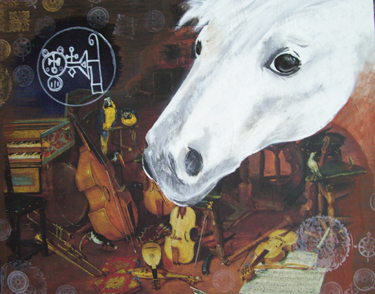
Terkildsen sees no glamour in an artist living off corn tortillas from the dollar store, nor does she have kind words for art critics. She keeps doing art for the feeling that comes from hearing the excitement in a few little girls’ voices at a recycling show. “I was fixing this skeleton inside this sculpture only to hear two little girls [exclaim], ‘Wow, that’s awesome,'” she said imitating their childish wonder. “How do you put a price tag on that reaction?”
Making Caesar and his friends into scapegoats for lowbrow art would only validate their convictions as monsters of the art form. Growing up, Caesar sympathized with the plight of the monsters in movies—Dracula’s eternal life, the Wolf Man’s inability to control his animalistic hunger. He sees the humanity in these pariahs. It brings to mind Caesar’s drawing of a zombie ghost feasting on a person’s head with the caption “What?! It’s what I do.”
“I was the oddball,” he said. “I was the weirdo and the freak. As an artist you’re perpetually shit on. It’s right back to the peasants and the pitchforks.” He takes comfort in being the artist who stands out from the landscape paintings, by being the guy next to the canvas bearing a bloody headless image.
On Saturday Oct. 24, 2009, Terkildsen and Caesar had a gallery showing and costume party at Side Show Studios at 5635 Freeport Blvd. Ste. 6.
Artist Kathy Blackburn is Thankful for the Here and Now

It’s fashionable to say, “The 30 is the new 20,” but in the case of Kathy Blackburn, the oft muttered phrase may hold true. An instructional coach working for the Elk Grove Unified District by day, Blackburn also has a passion for art.
“I always doodled a lot, but it wasn’t until 2000 that I made my first painting,” Blackburn said. “My husband is a musician, and he was off practicing a lot, and I thought, ‘I’m going to find something for me to do.’ So I went out and got a canvas and some paints, and it was like an epiphany moment. Here I am in my late 30s and I realize this is what I was supposed to be doing all along.”
Self-trained, Blackburn began showing her art in 2005. SaraJane & Co. will host her latest exhibition and mark the occasion with a three-day opening from Sept. 11-13. The four-person show will also feature Netherlands, Ed Phelps and one of Blackburn’s favorites, Mark Fox. Blackburn will be showing works from her current series of paintings titled Controlled Chaos. In a recent interview with Submerge, she shed some light on her latest series and explained why she feels she’s blossoming as an artist.
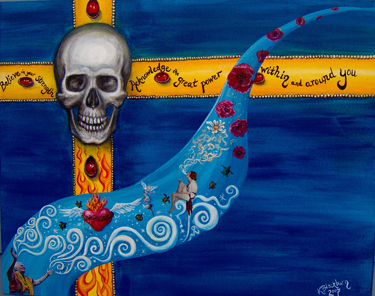
Does your professional life ever influence your creative life?
You know, that’s a good question. I guess the fact that I get to be surrounded by all kinds of interesting people from different cultures, and be with beautiful, happy, healthy children all the time, I think that definitely finds its way into my art.
Do you think that since you didn’t have any training, you were able to develop more freely?
You know what? I wish I did have more training. In fact I’d love to go back to school—back to the Academy of Art or something—and get someone to teach me all the techniques, because I do layer after layer to get what I want. There are quicker ways to do it if you know what you’re doing.
Also, at that time I was what they call a bilingual teacher, even though I wasn’t bilingual at all. I spent some time in Mexico taking language classes. All the art that I saw when I was in Mexico—all the bright colors and the folk art and the big murals—all that really influenced my art. My first paintings were of suns and moons, like you might see in Mexican folk art, and all that still influences my work today.
When you first sat down to paint, and you had the blank canvas in front of you, did you have an idea of what you wanted to do?
That first one I mapped out pretty carefully. I made a sun surrounded by four moons, and remember getting plates out and little dishes so I could make sure I had perfect circles. But you know what’s cool for me right now is that I’m at a phase where I don’t have to map out things carefully. Once I know what’s coming next, which takes me a while sometimes, I’m not having to make initial sketches. I just go right at it.
I wanted to talk about your current series, Controlled Chaos, is this the first time you’ve ever worked in a series?
Not really, but not on purpose, really. I did the suns and moons, and then I started doing a lot of portrait work and figurative work, which I still like. I still get commissions for that now and then, and I still put a lot of that into what I’m doing right now. But what happened was, I was doing all this figurative work, and a collector said, “I want you to make these paintings. I want them to be really large, I want them to be these colors, and I want them to be totally abstract.” And I had no idea how to go about doing that. I know the person liked Gustav Klimt, so I made made these big organic tubes and I filled them with all this patterning and gold leaf and stuff. That series is what led to the Controlled Chaos pieces, because now I have this structure where I can contain all my composition in the tubes, but all the figurative and portraiture stuff is coming back in. You can see that there is a lot more representational stuff in the paintings.
There’s a collage aspect to your work as well.
I experimented for a while with having the collage and having some realistic elements like that portrait of Einstein that I painted, because I wanted people to wonder, “What does she glue on and what does she paint?” But my most recent work has been a lot more painting and not just collage, so I don’t know if I’m moving on into a new phase or what.
What inspired you to experiment with collage in the first place?
I just think we’re so inundated with all these interesting images. Every time I open up a magazine or anything, I don’t look at the articles. The first thing I do is think, “What would be a good painting? What can I cut out and glue on something?” I have stacks and stacks of magazine, and I subscribe to weird things like Biblical Archaeology. Even now, when I kind of want a mental break, I do what I call collage therapy where I just randomly cut things out and find out what happens instead of making a real elaborate painting. One night, just get it done, and see what happens.
Why do you find yourself moving away from collage in your more recent paintings?
I think that’s what happening is that I’m feeling that my technical abilities are growing, so I feel more confident making a wide variety of images with the paint, and then of course I have more control. I can look at a picture I found in a magazine or on Google or whatever, but I can make it my own size or exaggerate features, or whatever. I think it’s just an extension of my powers growing.
You mentioned in your description of the series that the skulls were the focal point for Controlled Chaos. Were those images that you really wanted to use going into the painting of the series, or did you just notice skulls popping up in your work?
I made one big skull in the first painting I made in this series, and I just felt like the whole skull thing was a universal image. If I’d used your face or my face, you know there’s a man, there’s a woman. That person’s young, that person’s old, whatever. But that skull, that’s everybody’s future. That’s a much more universal symbol for all of us. That’s what I’m trying to explore: the mysteries that we all have to deal with all the time—the mysteries of the spiritual and the afterlife, yes, but also all of the myriad of things we have to deal with right now. That’s why skulls are the focal point, because it’s not about just me. It’s about all of us trying to figure out, “How do I live a decent life and be the person I want to be?”
Have you put any thought into a series you’d like to do next?
It’s interesting, because I’m still doing a lot of skull stuff, but I’ve noticed a lot of roses are coming in. I think I’m getting ready to bloom a little bit [laughs]. I’m not sure I can say. I can see some transitions happening.
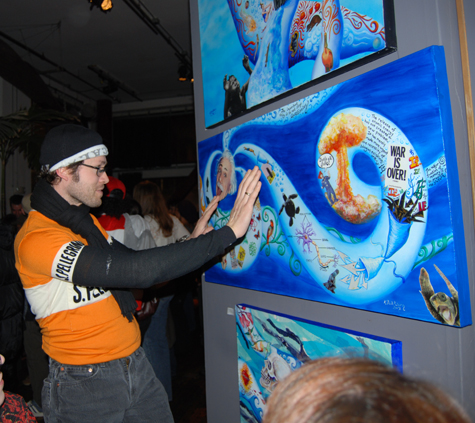
Lucky Number 13
There is a certain air of mystery surrounding places off the beaten path. Especially to those of us who live in urban areas, lonely country roads, small towns and backwoods locales—and the people who inhabit them—prey upon our fears and curiosities. Area artist Mark Fox has seen this theme surface in his work in recent years. Born in Sacramento and raised in Elk Grove, Fox now lives in Marysville with his wife. The couple has been there for two years, and Fox has mixed feelings on his new home.
“It’s OK,” he tells Submerge, taking a break from preparing for a few upcoming shows. “I prefer living in cities. I like downtown Sac, because you can walk around, and there are trees. Up here it’s a little different. It’s laid-back country style, I guess.”
The new location has had a noticeable affect on his work, however.
“You get those true characters up here,” Fox explains. “We have my favorite guy up here called Marysville George; he’s really rad. He’s inspiring. He’s all about positivity. I try to base some of my art characters on people I see around here.”
He goes to the say, “Marysville reminds me of Elk Grove like 10, 15 years ago when it was smaller. Now Elk Grove is a little bit bigger, but it has that small town feel. It’s cool though. Everyone knows each other up here [in Marysville].”
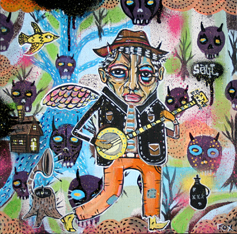
Apart from the change in scenery, Fox’s recent preoccupation with “hillbilly, folkish” art stems from the death of his mother around three years ago. His loss led him on a road to self-discovery as he ventured back to Tennessee where he learned about his mother’s Melungeon heritage.
Melungeons are people of mixed ethnic heritage who inhabit the southern Appalachian regions in Tennessee and Virginia.
“They don’t know where they originated from,” Fox says. “They’re considered not fully white, a little bit darker, so treated like African Americans back in they day.”
Fox says that incorporating Melungeon-inspired images into his work is a way of showing respect and a sense of pride for his mother’s ethnicity, especially since the group was often discriminated against and ostracized.
“I try to incorporate that and bring it out because it was such a derogative thing to be called a Melungeon,” he says. “They were considered boogey men.”

Though this phase has lasted a few years, the 34-year-old artist (who now paints full-time) has painted his whole life. The 13th of 14 children, Fox grew up in a religious household and his family didn’t always look favorably upon his art.
“I was diagnosed bi-polar, so ever since I was a kid, I think that’s been my therapy—my way of expressing all the problems I had in my head,” he says. “Recently, when my mom passed away, that added to it. That inspired me to put more meaning into my work.”
Fox points out that, though he incorporates a folk art feeling in his work, he likes to mix it up. Living in Sacramento for so long, Fox also likes to add an “urban aspect” to his painting as well. Also, further perusal of his work reveals his abstract leanings.
“I think a lot of it is how my mood is, how I feel about what I want to get out,” Fox explains. “I did start out more abstract. Artists like [Jean-Michel] Basquiat—that whole abstract expressionist movement, inspired me. I was hella inspired by those guys—just hardly any subject matter, just wild paint, expression.”
